- Home
- Resources
- Work samples
- Samples
- Data analysis: Water in the world – BELOW
Geography
Year 7
Below satisfactory
Data analysis: Water in the world
Copyright
Map data: Google, DigitalGlobe
 1
Annotation 1
1
Annotation 1
Describes in simple terms one way that people connect with water in the environment 2 Annotation 2
Identifies simple connections between people and water
-
Annotations
-
1
Annotation 1
Describes in simple terms one way that people connect with water in the environment -
2
Annotation 2
Identifies simple connections between people and water
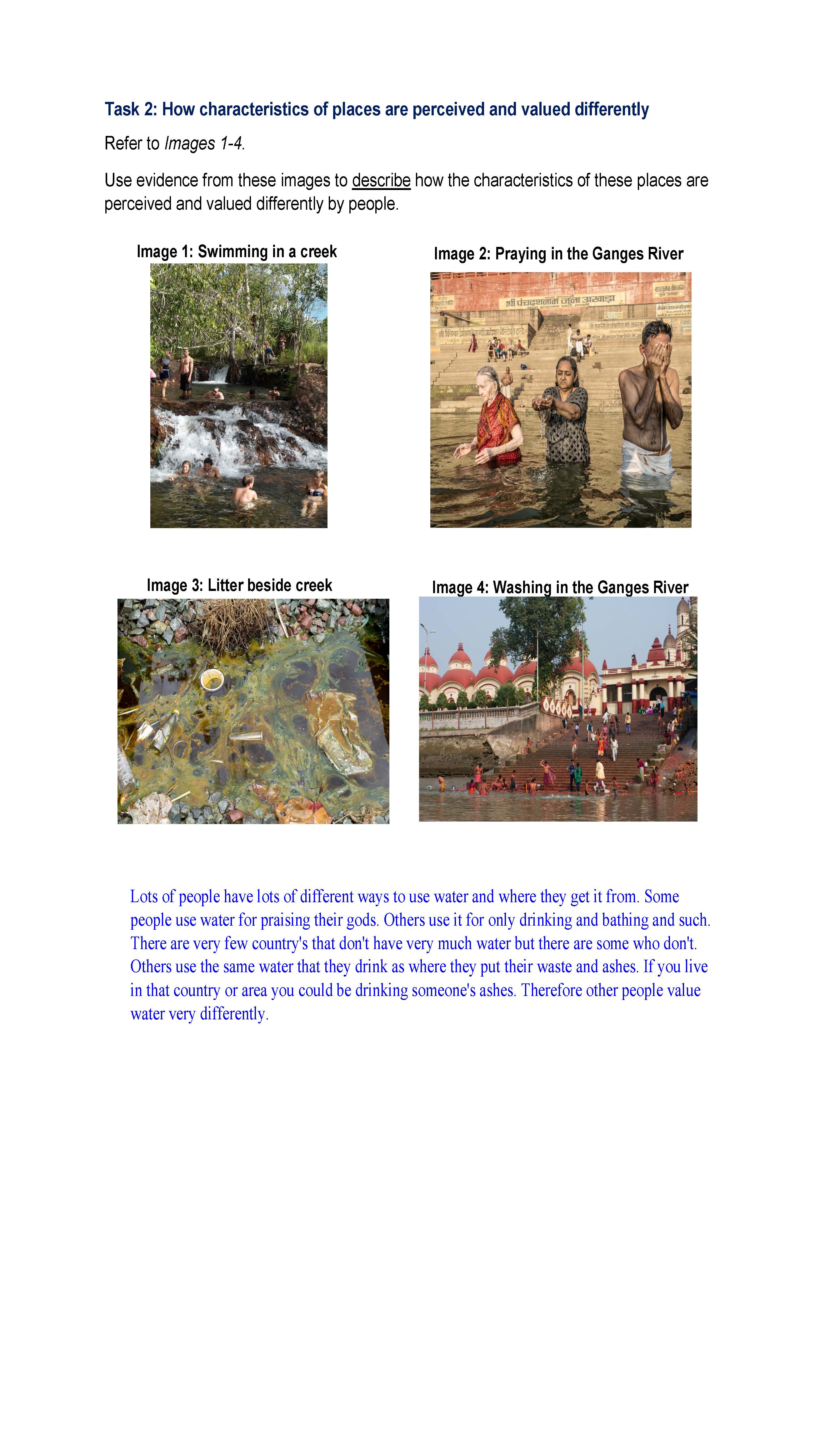 1
Annotation 1
1
Annotation 1
Presents a simple argument about a geographical phenomenon 2 Annotation 2
Identifies ways people use and value water 3 Annotation 3
Makes simple interpretations from geographical images 4 Annotation 4
Draws a conclusion about how people perceive and value different bodies of water
-
Annotations
-
1
Annotation 1
Presents a simple argument about a geographical phenomenon -
2
Annotation 2
Identifies ways people use and value water -
3
Annotation 3
Makes simple interpretations from geographical images -
4
Annotation 4
Draws a conclusion about how people perceive and value different bodies of water
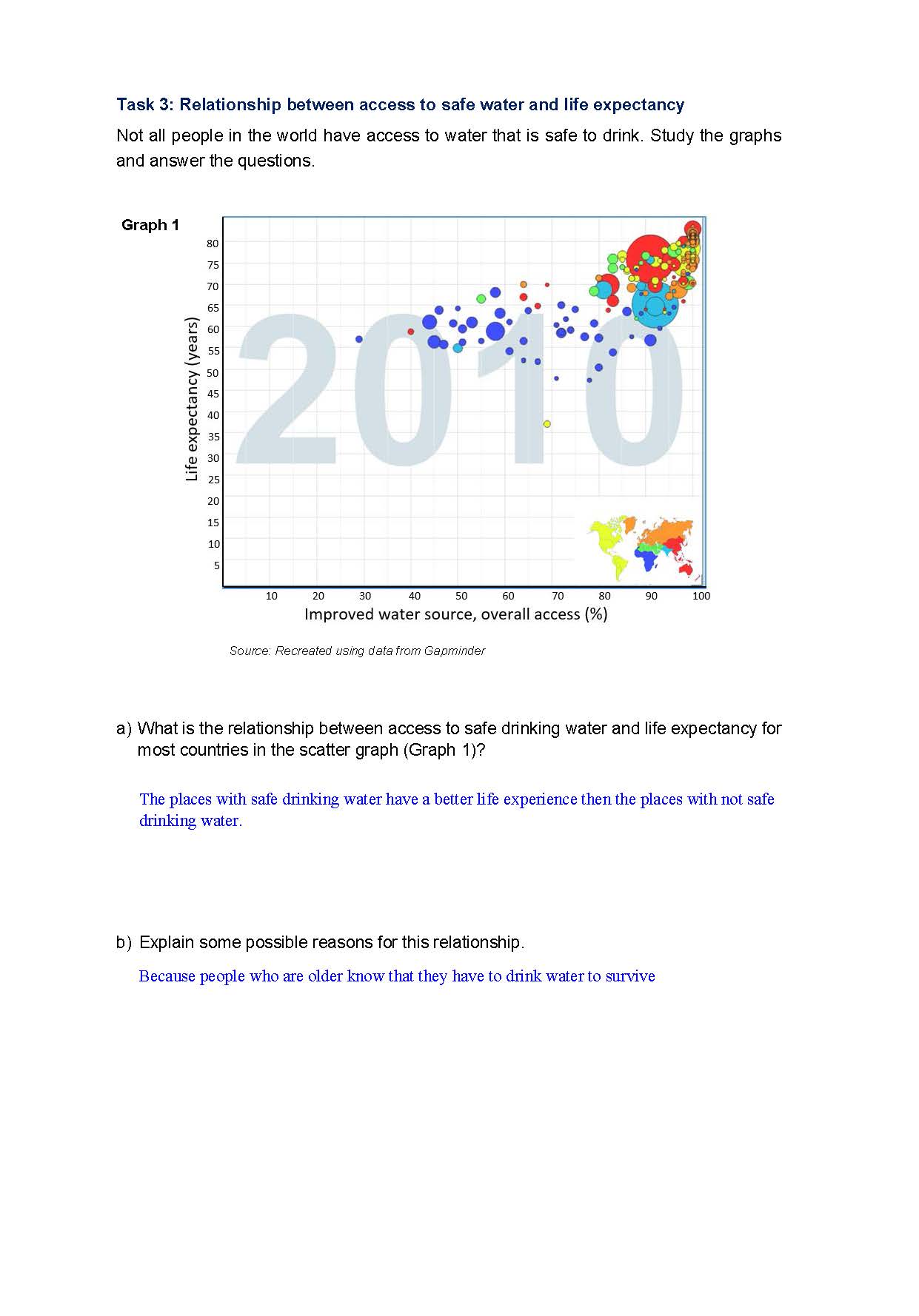 1
Annotation 1
1
Annotation 1
Identifies relationships between access to safe drinking water and life expectancy 2 Annotation 2
Interprets graphic data to draw a conclusion 3 Annotation 3
Describes a very simple reason for life expectancy and access to safe water
-
Annotations
-
1
Annotation 1
Identifies relationships between access to safe drinking water and life expectancy -
2
Annotation 2
Interprets graphic data to draw a conclusion -
3
Annotation 3
Describes a very simple reason for life expectancy and access to safe water
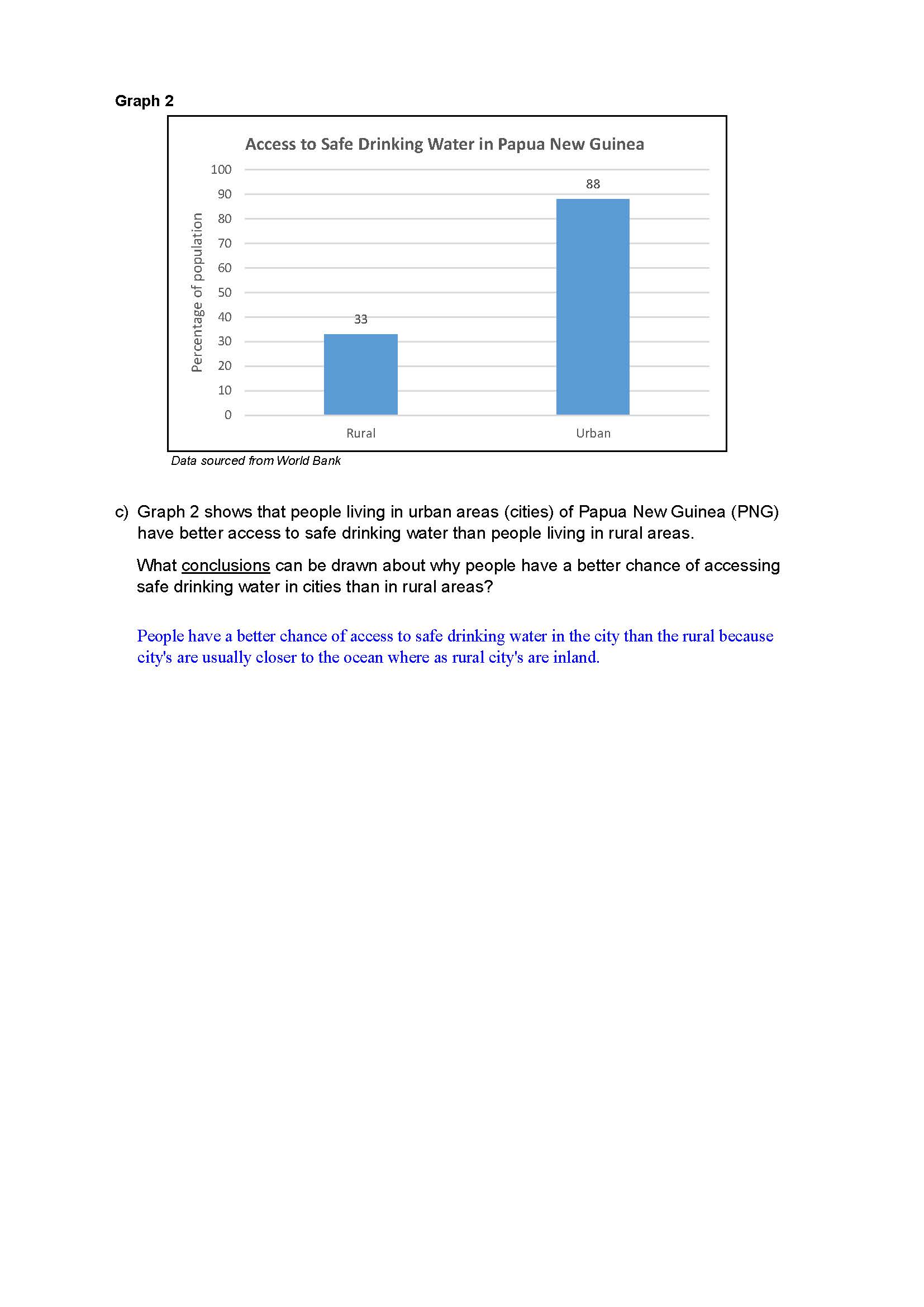 1
Annotation 1
1
Annotation 1
Draws a conclusion based on an assumption
-
Annotations
-
1
Annotation 1
Draws a conclusion based on an assumption
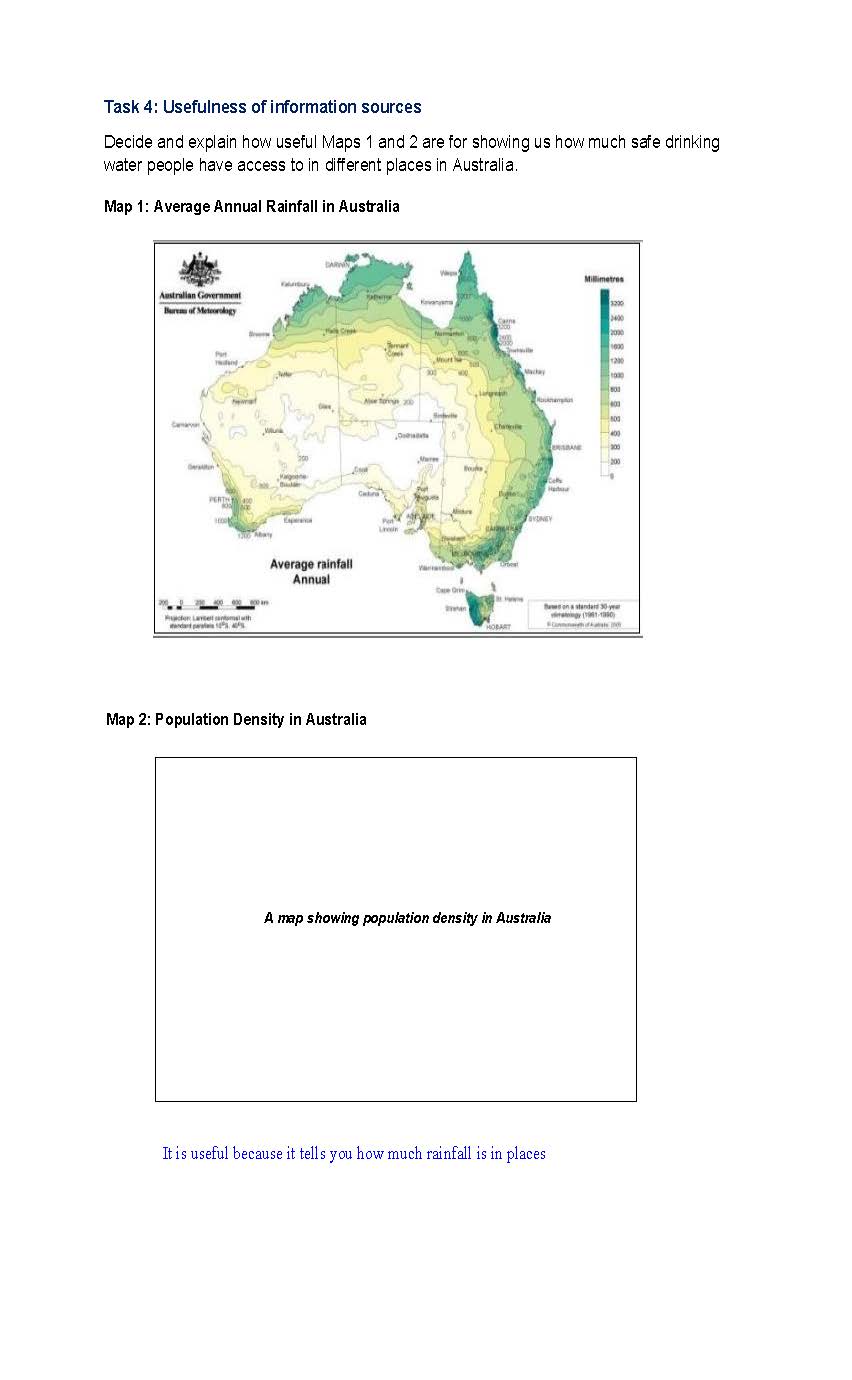 1
Annotation 1
1
Annotation 1
Offers a simple explanation for the usefulness of a map
-
Annotations
-
1
Annotation 1
Offers a simple explanation for the usefulness of a map
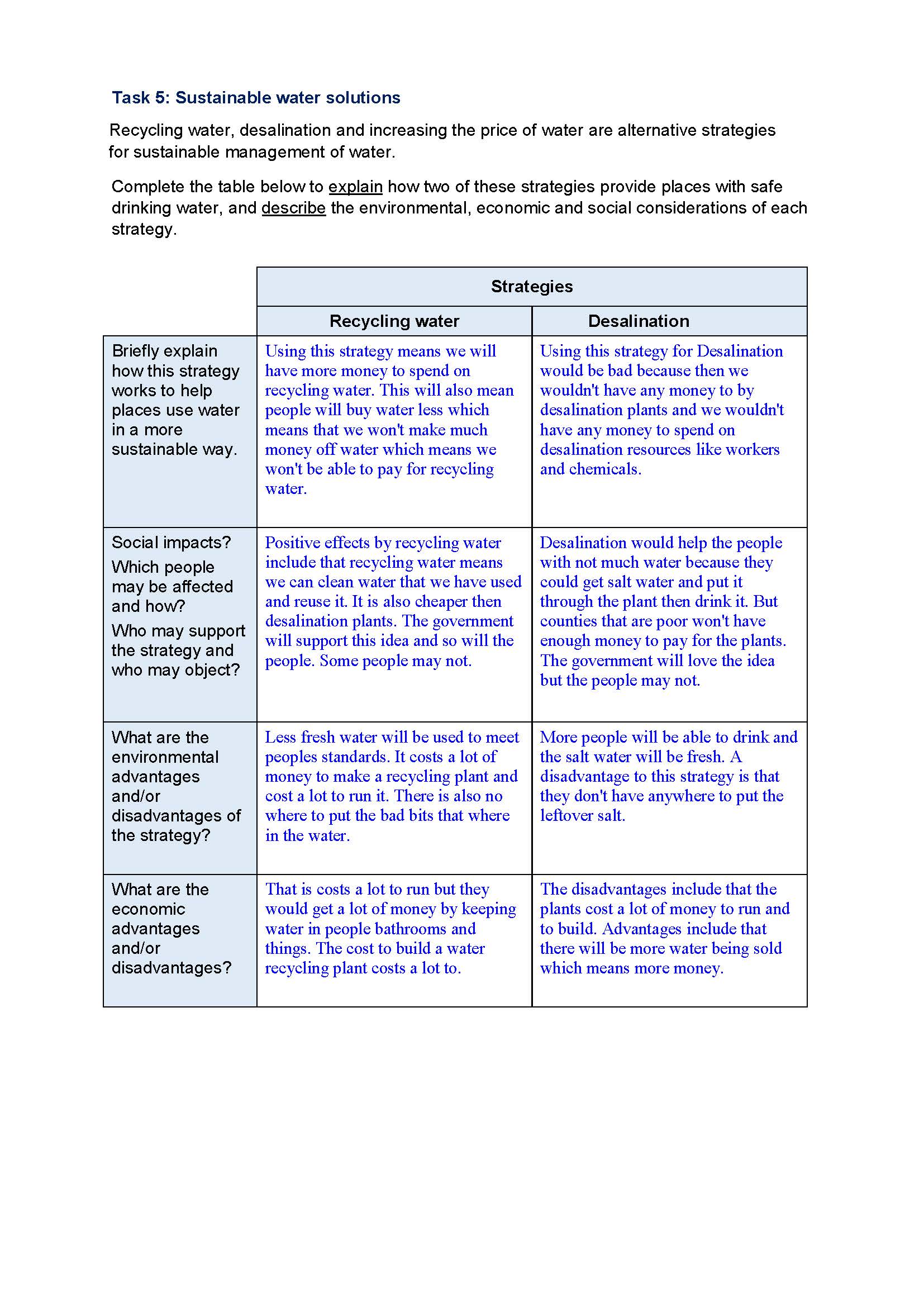 1
Annotation 1
1
Annotation 1
Identifies strategies to address the challenge of water sustainability 2 Annotation 2
Describes positive effects of water recycling for people 3 Annotation 3
Describes simple positive and negative effects of desalination on people 4 Annotation 4
Identifies a connection between desalination plants and people’s social and economic status 5 Annotation 5
Describes simple negative and positive environmental effects of desalination 6 Annotation 6
Describes simple negative and positive economic impacts of water recycling and desalination
-
Annotations
-
1
Annotation 1
Identifies strategies to address the challenge of water sustainability -
2
Annotation 2
Describes positive effects of water recycling for people -
3
Annotation 3
Describes simple positive and negative effects of desalination on people -
4
Annotation 4
Identifies a connection between desalination plants and people’s social and economic status -
5
Annotation 5
Describes simple negative and positive environmental effects of desalination -
6
Annotation 6
Describes simple negative and positive economic impacts of water recycling and desalination
Above satisfactory
Data analysis: Water in the world
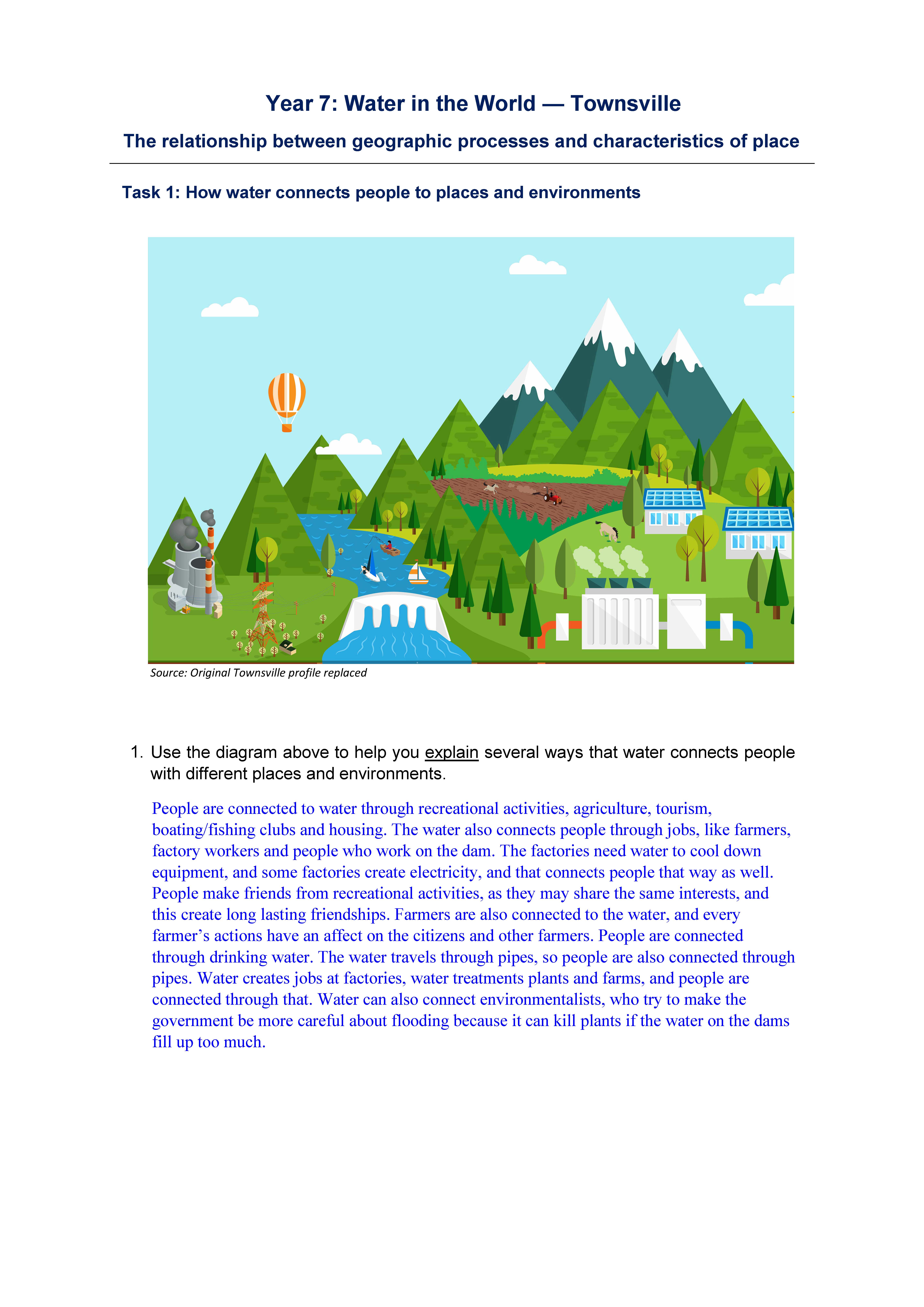 1
Annotation 1
1
Annotation 1
Clearly articulates the overall connection between water, people, places and environments 2 Annotation 2
Explains a connection between people's use of water and its impact on the environment 3 Annotation 3
Predicts a geographical outcome using a conceptual argument
-
Annotations
-
1
Annotation 1
Clearly articulates the overall connection between water, people, places and environments -
2
Annotation 2
Explains a connection between people's use of water and its impact on the environment -
3
Annotation 3
Predicts a geographical outcome using a conceptual argument
 1
Annotation 1
1
Annotation 1
Provides a comprehensive description of how interconnections change places and environments 2 Annotation 2
Uses relevant geographical terminology in appropriate context 3 Annotation 3
Draws conclusions using multiple connections from the diagram 4 Annotation 4
Describes in detail the interconnections between people's actions and the environment
-
Annotations
-
1
Annotation 1
Provides a comprehensive description of how interconnections change places and environments -
2
Annotation 2
Uses relevant geographical terminology in appropriate context -
3
Annotation 3
Draws conclusions using multiple connections from the diagram -
4
Annotation 4
Describes in detail the interconnections between people's actions and the environment
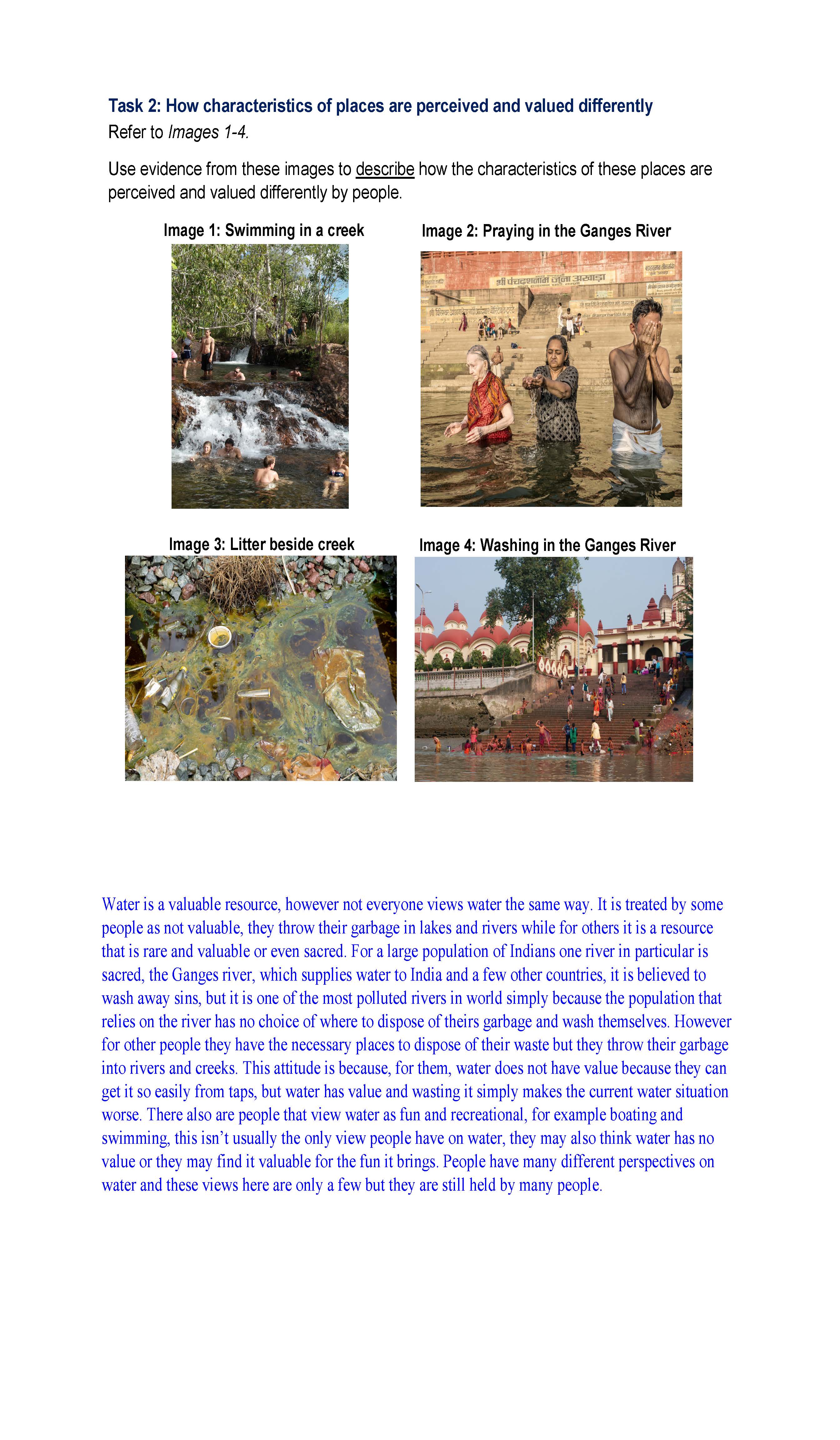 1
Annotation 1
1
Annotation 1
Presents an argument about a geographical phenomenon 2 Annotation 2
Describes a reason why people may perceive and value water differently 3 Annotation 3
Explains the challenges associated with multiple uses of a single body of water 4 Annotation 4
Proposes an explanation for negative use of water 5 Annotation 5
Synthesises evidence from multiple sources 6 Annotation 6
Draws a conclusion about how people view water differently
-
Annotations
-
1
Annotation 1
Presents an argument about a geographical phenomenon -
2
Annotation 2
Describes a reason why people may perceive and value water differently -
3
Annotation 3
Explains the challenges associated with multiple uses of a single body of water -
4
Annotation 4
Proposes an explanation for negative use of water -
5
Annotation 5
Synthesises evidence from multiple sources -
6
Annotation 6
Draws a conclusion about how people view water differently
 1
Annotation 1
1
Annotation 1
Describes accurately a geographic trend, citing specific data from the graph 2 Annotation 2
Identifies relationships between variables (access to safe drinking water and life expectancy) 3 Annotation 3
Describes accurately a geographic trend, citing specific data from the graph 4 Annotation 4
Uses relevant geographical terminology 5 Annotation 5
Syntheses data to draw a detailed conclusion 6 Annotation 6
Explains how access to safe drinking water is connected to life expectancy, citing examples from the graph
-
Annotations
-
1
Annotation 1
Describes accurately a geographic trend, citing specific data from the graph -
2
Annotation 2
Identifies relationships between variables (access to safe drinking water and life expectancy) -
3
Annotation 3
Describes accurately a geographic trend, citing specific data from the graph -
4
Annotation 4
Uses relevant geographical terminology -
5
Annotation 5
Syntheses data to draw a detailed conclusion -
6
Annotation 6
Explains how access to safe drinking water is connected to life expectancy, citing examples from the graph
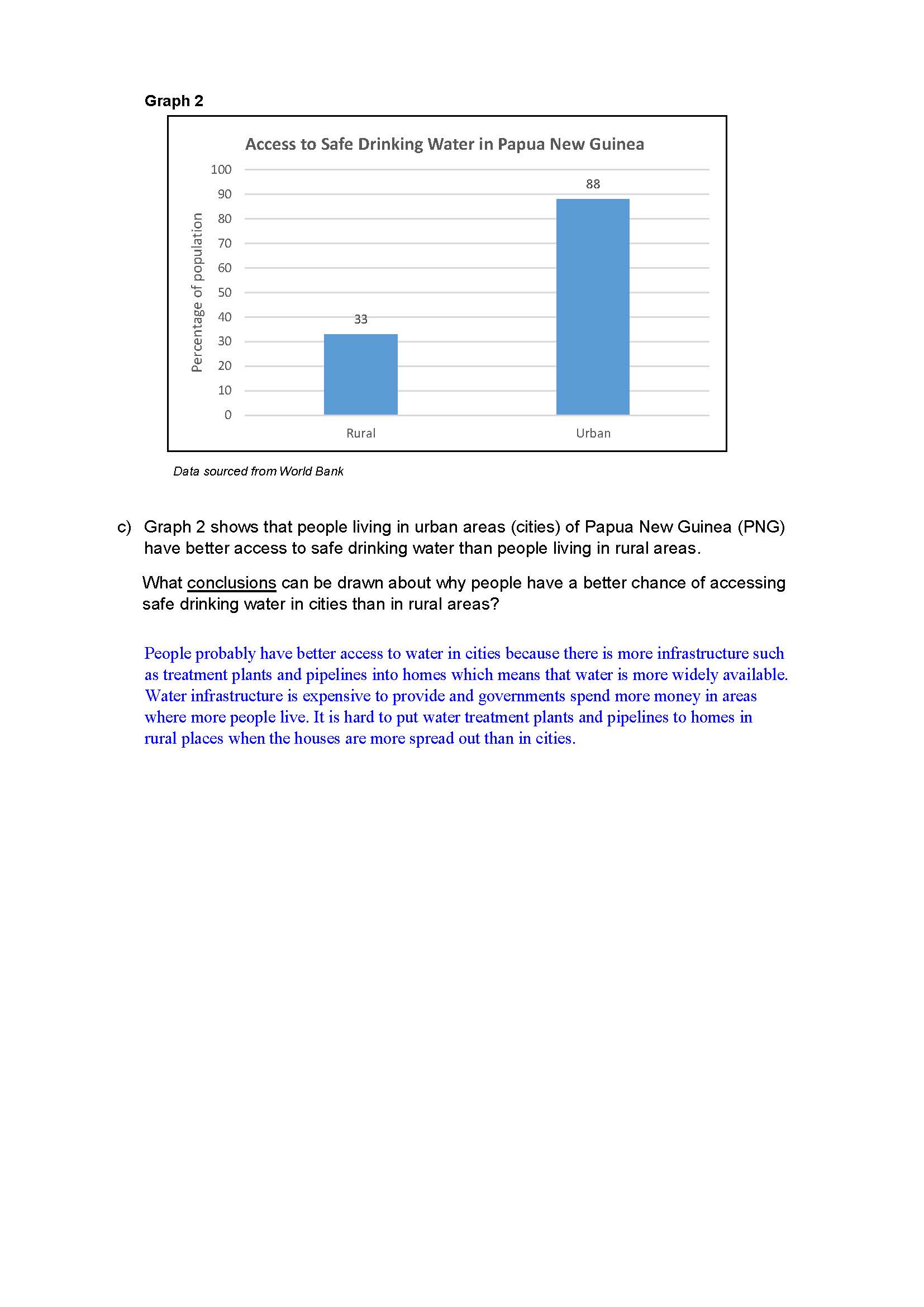 1
Annotation 1
1
Annotation 1
Uses relevant geographical terminology 2 Annotation 2
Draws a reasoned, detailed conclusion based on the data provided in the graph, using examples
-
Annotations
-
1
Annotation 1
Uses relevant geographical terminology -
2
Annotation 2
Draws a reasoned, detailed conclusion based on the data provided in the graph, using examples
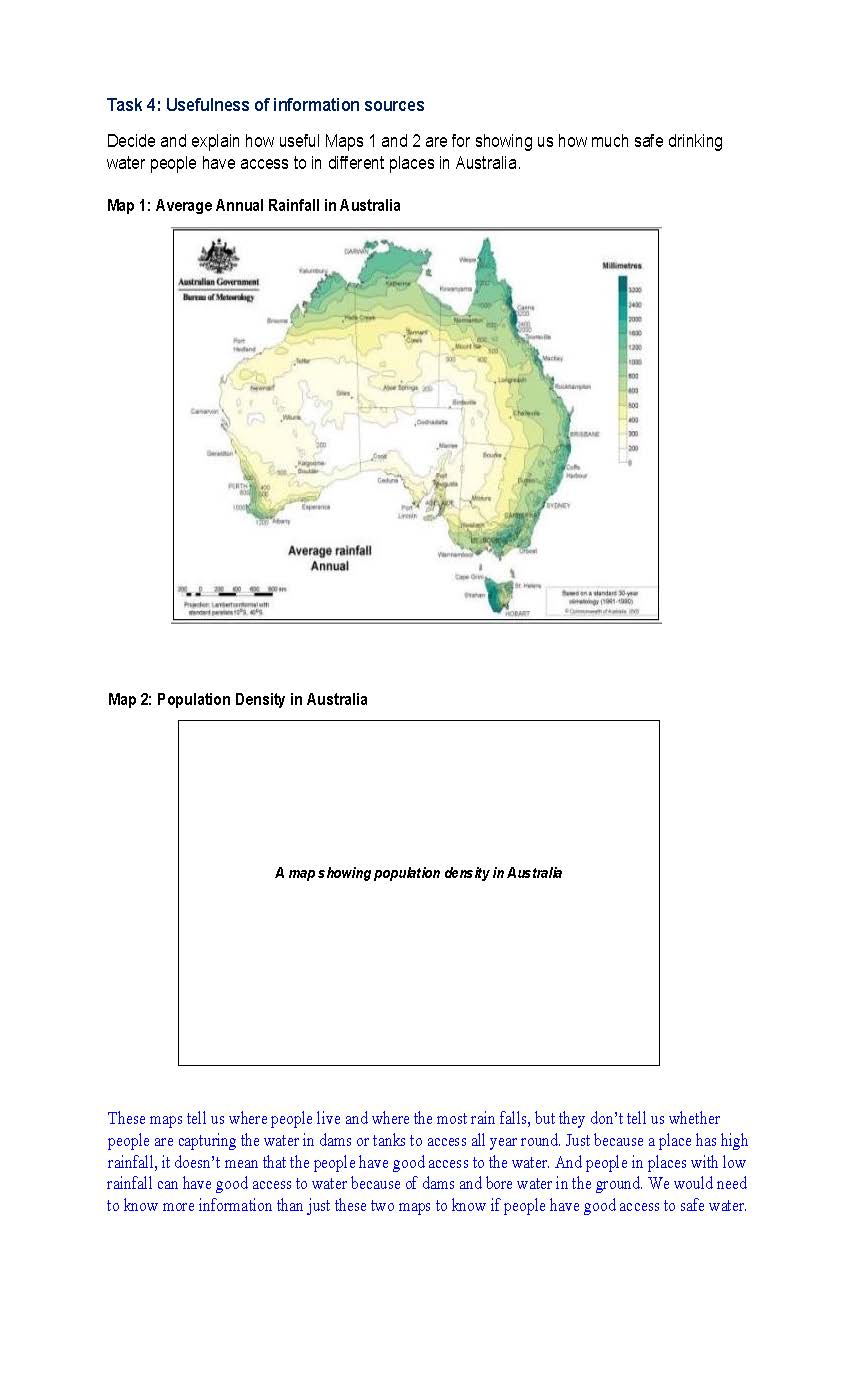 1
Annotation 1
1
Annotation 1
Identifies the purpose of different maps 2 Annotation 2
Justifies the need for more information by acknowledging each map's limitations 3 Annotation 3
Uses both maps to explain in detail trends and relationships about rainfall and population
-
Annotations
-
1
Annotation 1
Identifies the purpose of different maps -
2
Annotation 2
Justifies the need for more information by acknowledging each map's limitations -
3
Annotation 3
Uses both maps to explain in detail trends and relationships about rainfall and population
 1
Annotation 1
1
Annotation 1
Identifies strategies to address the challenge of water sustainability 2 Annotation 2
Explains in detail the processes of water recycling and desalination 3 Annotation 3
Identifies possible positive and negative social and economic factors linked to recycled water and desalination 4 Annotation 4
Connects sustainable strategies for water to society and the environment 5 Annotation 5
Outlines positive and negative economic impacts associated with water recycling and desalination, using examples 6 Annotation 6
Identifies and explains a connection between desalination, the economy and the environment 7 Annotation 7
Explains economic advantages and disadvantages of water recycling and desalination on society and the economy, using specific examples 8 Annotation 8
Draws conclusions about the effects of water recycling and desalination
-
Annotations
-
1
Annotation 1
Identifies strategies to address the challenge of water sustainability -
2
Annotation 2
Explains in detail the processes of water recycling and desalination -
3
Annotation 3
Identifies possible positive and negative social and economic factors linked to recycled water and desalination -
4
Annotation 4
Connects sustainable strategies for water to society and the environment -
5
Annotation 5
Outlines positive and negative economic impacts associated with water recycling and desalination, using examples -
6
Annotation 6
Identifies and explains a connection between desalination, the economy and the environment -
7
Annotation 7
Explains economic advantages and disadvantages of water recycling and desalination on society and the economy, using specific examples -
8
Annotation 8
Draws conclusions about the effects of water recycling and desalination
Satisfactory
Data analysis: Water in the world
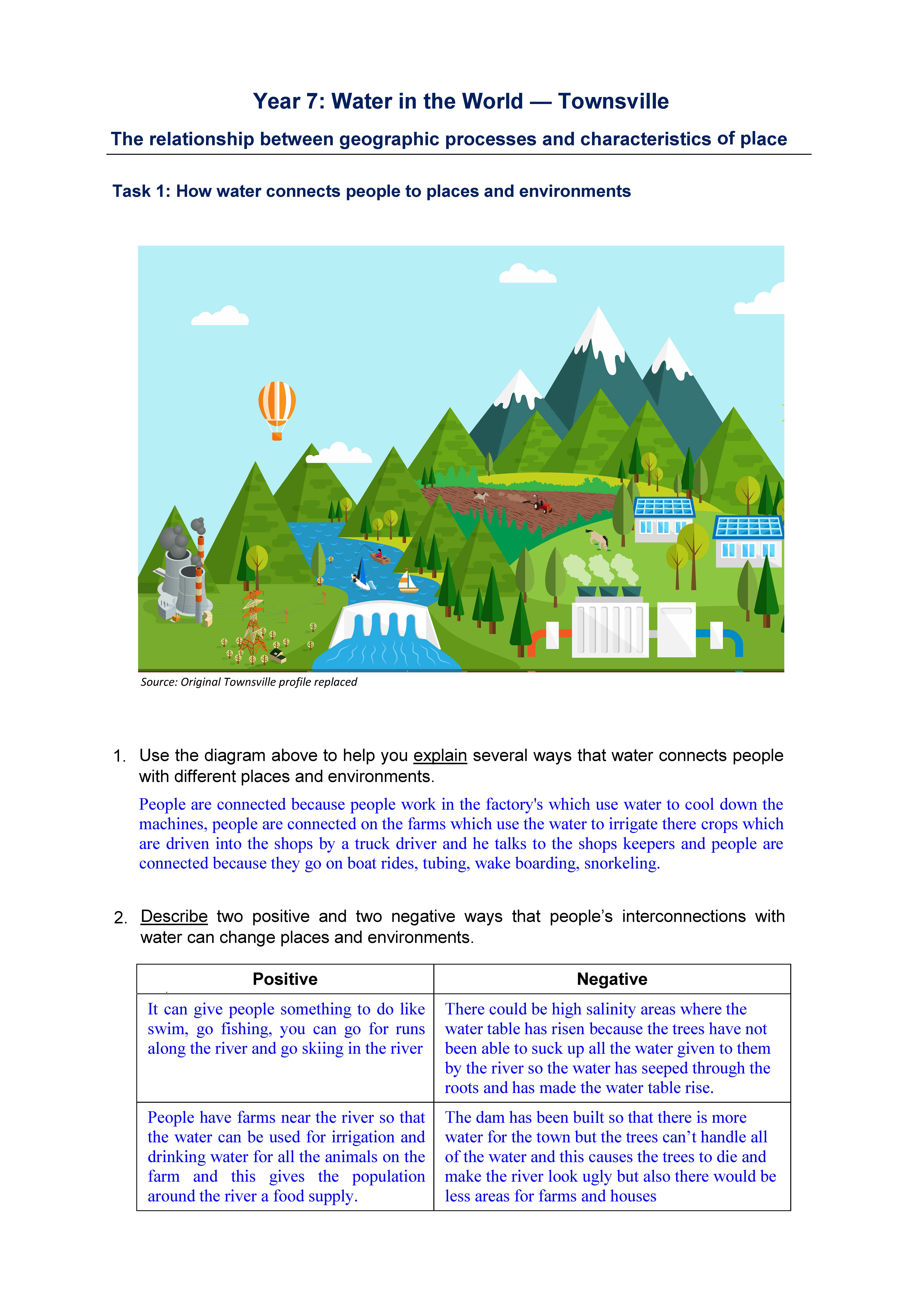 1
Annotation 1
1
Annotation 1
Explains ways water connects people with different places and environments 2 Annotation 2
Describes geographical processes 3 Annotation 3
Describes interconnections between people and water 4 Annotation 4
Describes how people’s interconnections change places and environments 5 Annotation 5
Uses some geographical terminology
-
Annotations
-
1
Annotation 1
Explains ways water connects people with different places and environments -
2
Annotation 2
Describes geographical processes -
3
Annotation 3
Describes interconnections between people and water -
4
Annotation 4
Describes how people’s interconnections change places and environments -
5
Annotation 5
Uses some geographical terminology
 1
Annotation 1
1
Annotation 1
Presents argument about a geographical phenomenon 2 Annotation 2
Describes ways people engage with and value bodies of water 3 Annotation 3
Analyses evidence in geographical images to draw conclusions 4 Annotation 4
Describes positive as well as negative impacts people have on a body of water
-
Annotations
-
1
Annotation 1
Presents argument about a geographical phenomenon -
2
Annotation 2
Describes ways people engage with and value bodies of water -
3
Annotation 3
Analyses evidence in geographical images to draw conclusions -
4
Annotation 4
Describes positive as well as negative impacts people have on a body of water
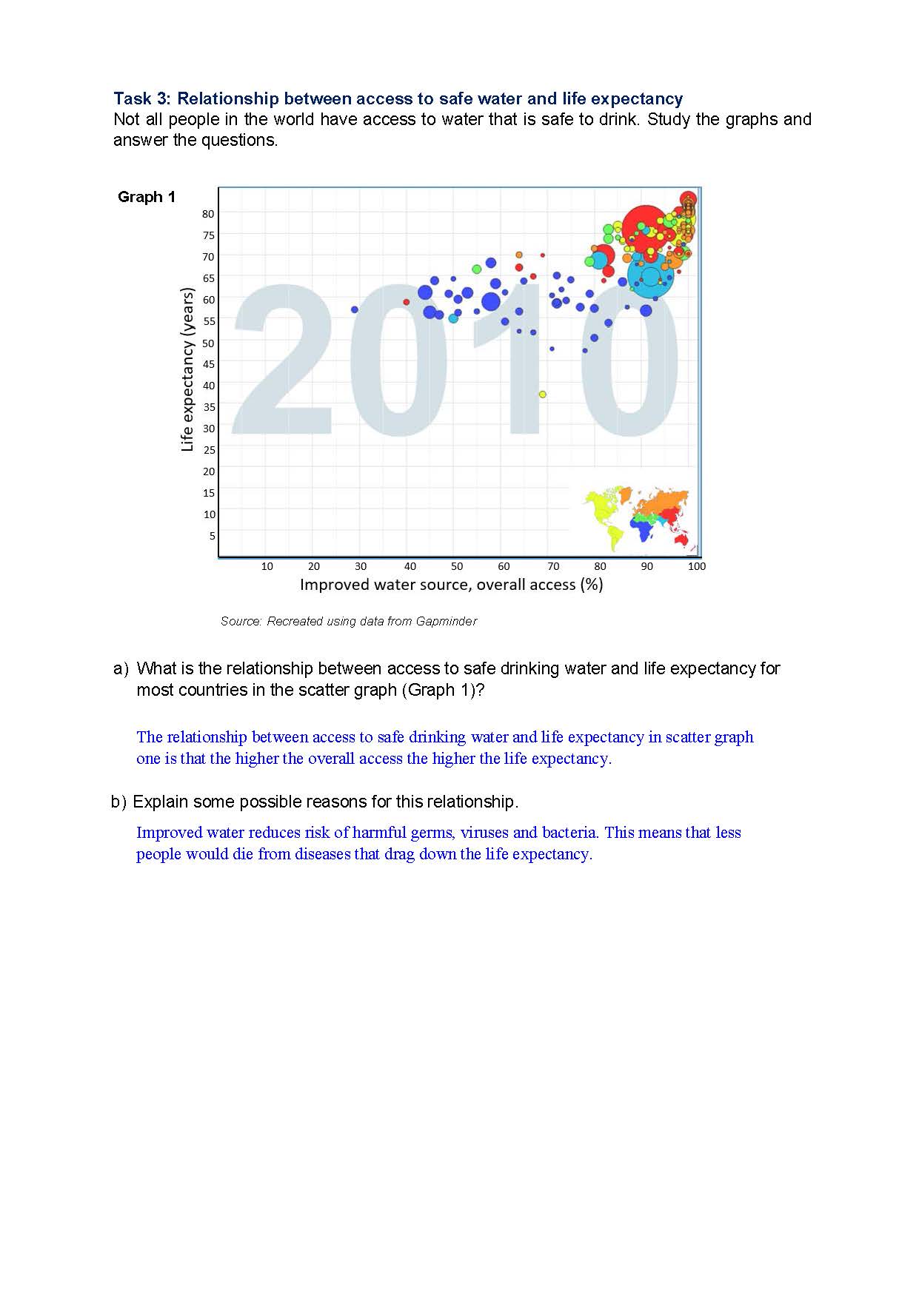 1
Annotation 1
1
Annotation 1
Identifies relationships between the variables, access to safe drinking water and life expectancy 2 Annotation 2
Accurately interprets graphic data to draw conclusions 3 Annotation 3
Explains how access to safe drinking water is connected to life expectancy
-
Annotations
-
1
Annotation 1
Identifies relationships between the variables, access to safe drinking water and life expectancy -
2
Annotation 2
Accurately interprets graphic data to draw conclusions -
3
Annotation 3
Explains how access to safe drinking water is connected to life expectancy
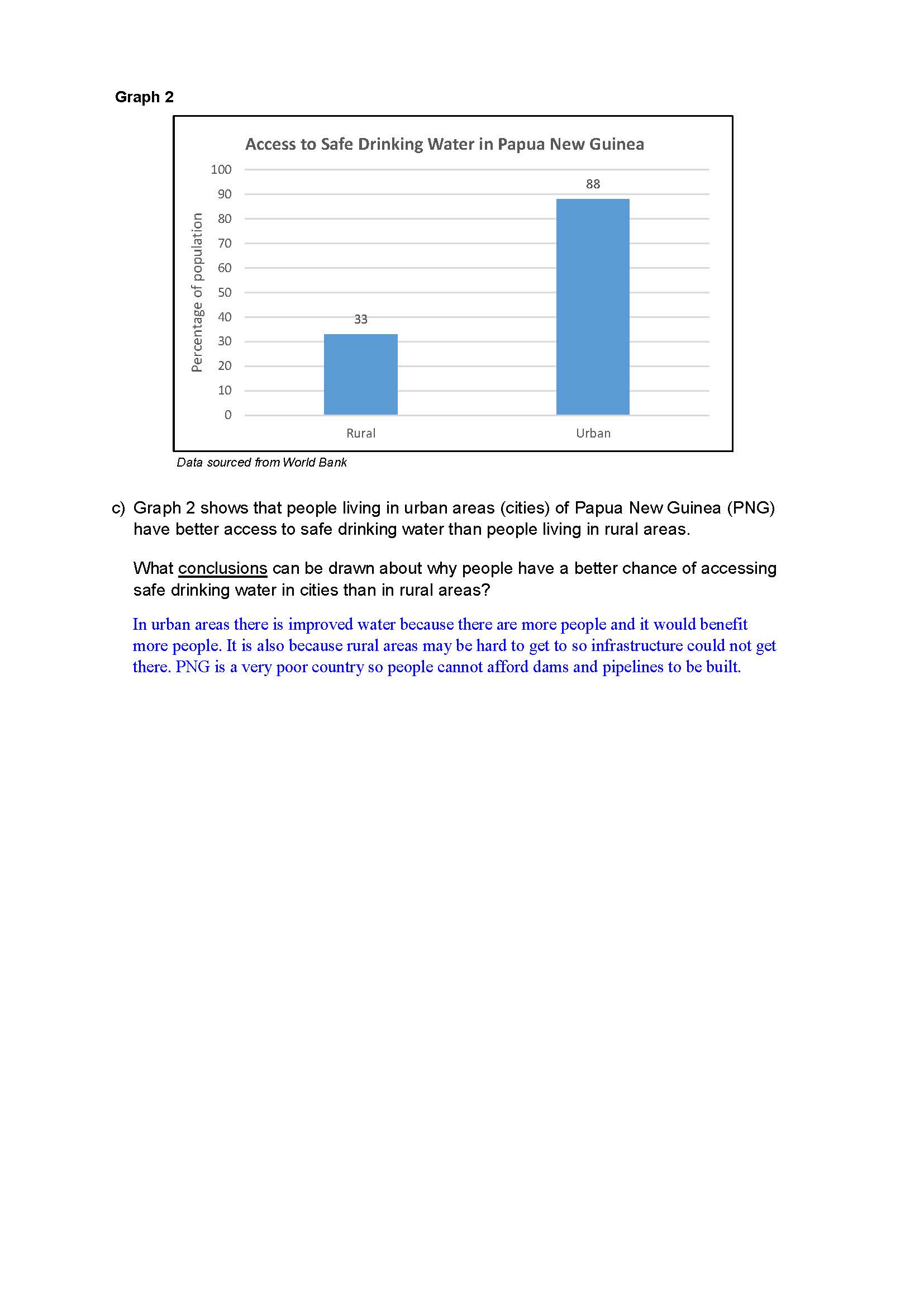 1
Annotation 1
1
Annotation 1
Draws a reasoned conclusion based on the data provided in a graph, using an example
-
Annotations
-
1
Annotation 1
Draws a reasoned conclusion based on the data provided in a graph, using an example
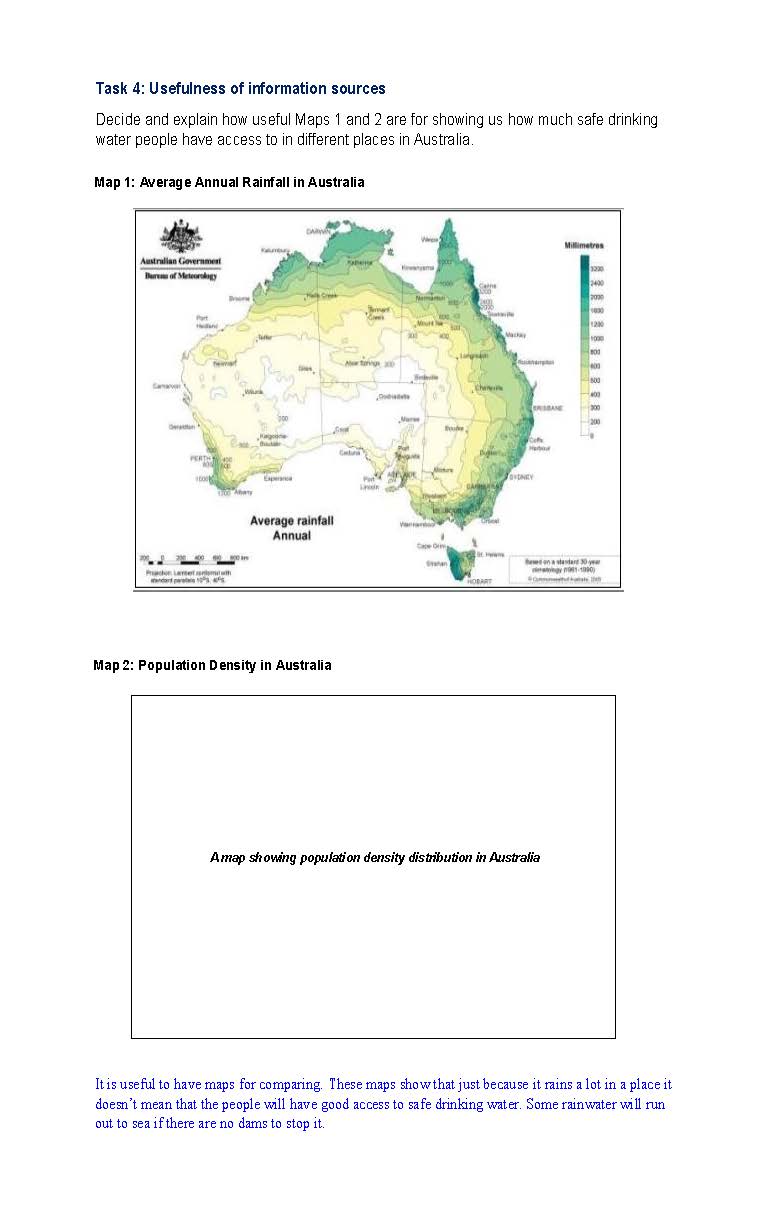 1
Annotation 1
1
Annotation 1
Describes the usefulness and relevance of more than one map to compare data 2 Annotation 2
Interprets information from maps to draw conclusions about connections between rainfall and population
-
Annotations
-
1
Annotation 1
Describes the usefulness and relevance of more than one map to compare data -
2
Annotation 2
Interprets information from maps to draw conclusions about connections between rainfall and population
 1
Annotation 1
1
Annotation 1
Identifies strategies to address the challenge of water sustainability 2 Annotation 2
Explains the processes of water recycling and desalination with some details 3 Annotation 3
Makes a simple connection between the process of water recycling and sustainability 4 Annotation 4
Identifies a range of social benefits and people associated with water recycling and desalination 5 Annotation 5
Identifies positive environmental impacts of water recycling and desalination 6 Annotation 6
Identifies a connection between desalination and the environment 7 Annotation 7
Identifies negative economic effects of water recycling and desalination 8 Annotation 8
Uses relevant geographical terminology
-
Annotations
-
1
Annotation 1
Identifies strategies to address the challenge of water sustainability -
2
Annotation 2
Explains the processes of water recycling and desalination with some details -
3
Annotation 3
Makes a simple connection between the process of water recycling and sustainability -
4
Annotation 4
Identifies a range of social benefits and people associated with water recycling and desalination -
5
Annotation 5
Identifies positive environmental impacts of water recycling and desalination -
6
Annotation 6
Identifies a connection between desalination and the environment -
7
Annotation 7
Identifies negative economic effects of water recycling and desalination -
8
Annotation 8
Uses relevant geographical terminology
Below satisfactory
Data analysis: Water in the world
Copyright
Map data: Google, DigitalGlobe
 1
Annotation 1
1
Annotation 1
Describes in simple terms one way that people connect with water in the environment 2 Annotation 2
Identifies simple connections between people and water
-
Annotations
-
1
Annotation 1
Describes in simple terms one way that people connect with water in the environment -
2
Annotation 2
Identifies simple connections between people and water
 1
Annotation 1
1
Annotation 1
Presents a simple argument about a geographical phenomenon 2 Annotation 2
Identifies ways people use and value water 3 Annotation 3
Makes simple interpretations from geographical images 4 Annotation 4
Draws a conclusion about how people perceive and value different bodies of water
-
Annotations
-
1
Annotation 1
Presents a simple argument about a geographical phenomenon -
2
Annotation 2
Identifies ways people use and value water -
3
Annotation 3
Makes simple interpretations from geographical images -
4
Annotation 4
Draws a conclusion about how people perceive and value different bodies of water
 1
Annotation 1
1
Annotation 1
Identifies relationships between access to safe drinking water and life expectancy 2 Annotation 2
Interprets graphic data to draw a conclusion 3 Annotation 3
Describes a very simple reason for life expectancy and access to safe water
-
Annotations
-
1
Annotation 1
Identifies relationships between access to safe drinking water and life expectancy -
2
Annotation 2
Interprets graphic data to draw a conclusion -
3
Annotation 3
Describes a very simple reason for life expectancy and access to safe water
 1
Annotation 1
1
Annotation 1
Draws a conclusion based on an assumption
-
Annotations
-
1
Annotation 1
Draws a conclusion based on an assumption
 1
Annotation 1
1
Annotation 1
Offers a simple explanation for the usefulness of a map
-
Annotations
-
1
Annotation 1
Offers a simple explanation for the usefulness of a map
 1
Annotation 1
1
Annotation 1
Identifies strategies to address the challenge of water sustainability 2 Annotation 2
Describes positive effects of water recycling for people 3 Annotation 3
Describes simple positive and negative effects of desalination on people 4 Annotation 4
Identifies a connection between desalination plants and people’s social and economic status 5 Annotation 5
Describes simple negative and positive environmental effects of desalination 6 Annotation 6
Describes simple negative and positive economic impacts of water recycling and desalination
-
Annotations
-
1
Annotation 1
Identifies strategies to address the challenge of water sustainability -
2
Annotation 2
Describes positive effects of water recycling for people -
3
Annotation 3
Describes simple positive and negative effects of desalination on people -
4
Annotation 4
Identifies a connection between desalination plants and people’s social and economic status -
5
Annotation 5
Describes simple negative and positive environmental effects of desalination -
6
Annotation 6
Describes simple negative and positive economic impacts of water recycling and desalination